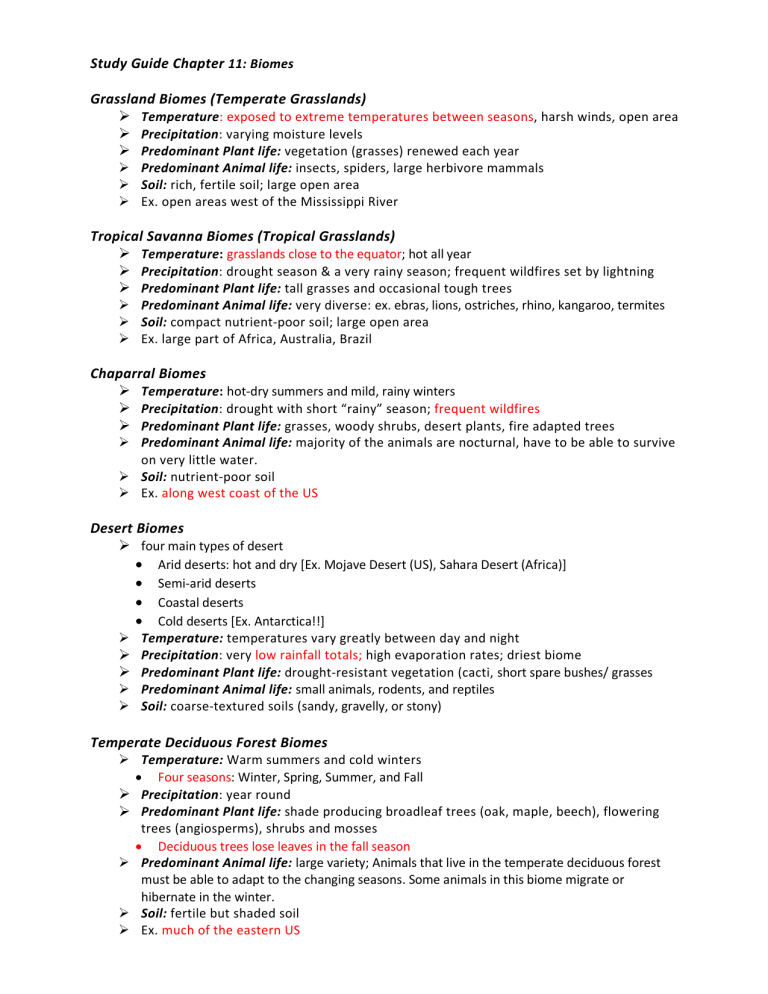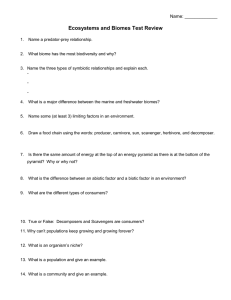
Study Guide Chapter 11: Biomes Grassland Biomes (Temperate Grasslands) Temperature: exposed to extreme temperatures between seasons, harsh winds, open area Precipitation: varying moisture levels Predominant Plant life: vegetation (grasses) renewed each year Predominant Animal life: insects, spiders, large herbivore mammals Soil: rich, fertile soil; large open area Ex. open areas west of the Mississippi River Tropical Savanna Biomes (Tropical Grasslands) Temperature: grasslands close to the equator; hot all year Precipitation: drought season & a very rainy season; frequent wildfires set by lightning Predominant Plant life: tall grasses and occasional tough trees Predominant Animal life: very diverse: ex. ebras, lions, ostriches, rhino, kangaroo, termites Soil: compact nutrient-poor soil; large open area Ex. large part of Africa, Australia, Brazil Chaparral Biomes Temperature: hot-dry summers and mild, rainy winters Precipitation: drought with short “rainy” season; frequent wildfires Predominant Plant life: grasses, woody shrubs, desert plants, fire adapted trees Predominant Animal life: majority of the animals are nocturnal, have to be able to survive on very little water. Soil: nutrient-poor soil Ex. along west coast of the US Desert Biomes four main types of desert Arid deserts: hot and dry [Ex. Mojave Desert (US), Sahara Desert (Africa)] Semi-arid deserts Coastal deserts Cold deserts [Ex. Antarctica!!] Temperature: temperatures vary greatly between day and night Precipitation: very low rainfall totals; high evaporation rates; driest biome Predominant Plant life: drought-resistant vegetation (cacti, short spare bushes/ grasses Predominant Animal life: small animals, rodents, and reptiles Soil: coarse-textured soils (sandy, gravelly, or stony) Temperate Deciduous Forest Biomes Temperature: Warm summers and cold winters Four seasons: Winter, Spring, Summer, and Fall Precipitation: year round Predominant Plant life: shade producing broadleaf trees (oak, maple, beech), flowering trees (angiosperms), shrubs and mosses Deciduous trees lose leaves in the fall season Predominant Animal life: large variety; Animals that live in the temperate deciduous forest must be able to adapt to the changing seasons. Some animals in this biome migrate or hibernate in the winter. Soil: fertile but shaded soil Ex. much of the eastern US Tropical Rain Forest Biomes The rainforest can be divided up into four layers. Different animals and plants live in each different layer. Emergent Layer: tall trees that stick up above the canopy Canopy: top umbrella layer of trees. Most plants & animals live here like: monkeys, birds, insects and reptiles. Noisiest layer Understory: mostly the trunks of canopy trees, some shorter trees and shrubs. Home to snakes, leopards, owls, bats, insects, frogs Forest floor: very little sunlight. Home to insects, spiders, pigs, deer. Quietest layer Temperature: hot all year Precipitation: wet all year Predominant Plant / Animal life: large variety; most biodiversity of all the land biomes; most productive and diverse biomes on earth Soil: soil in a rainforest is shallow and has little nutrients Ex. Amazon Rain Forest (South America) - This is the world's largest tropical rainforest. Taiga / Boreal Forest Biomes (ty-ga) Temperature: long, cold winters and short, mild summers Precipitation: moderate (mostly snow); high humidity Predominant Plant life: dense coniferous trees (pine, spruce, fir), lichens and mosses Most coniferous trees are evergreen, needles are good for retaining water and shedding snow Coniferous trees are cone-bearing Predominant Animal life: many migratory birds in the spring/summer, less variety of mammals than deciduous forests – Animals have cold adaptations like: thick fur/feathers, large feet or claws, fat layers, hibernation, winter coloring Soil: only a thin layer of soil; highly acidic and low in nitrogen Ex. largest land biome. large part of Canada, Asia and Europe; found between the tundra and deciduous forests; tundra and taiga represent the two coldest land biomes on the planet Alpine Tundra Biomes The Alpine Tundra is a unique biome in that it's found all over the globe, but only on tops of the tallest mountains. Extreme climate, harsh winds, steep slopes, thin dry soils, and low air pressure makes much of the alpine tundra uninhabitable. Temperature: low temperatures; harsh cold winds; rapidly changing weather Precipitation: low precipitation Predominant Plant life: low-lying mosses, dwarf shrubs, NO TREES Predominant Animal life: varies but all have adaptations for cold climate, thick fur/feathers, color changes, etc Soil: thin, dry, and poorly developed soils Ex. Rocky Mountains, Norway Arctic (Polar) Tundra Biomes This biome forms a belt around the arctic ocean, a transition zone from taiga to the polar ice caps Temperature: long, cold, dark winters & short cool summers Precipitation: very low precipitation, dry winds Predominant Plant life: low biodiversity; must have shallow roots; NO TREES Predominant Animal life: migrant animals such as caribou & birds; only 48 resident land mammals Soil: thin active layer with permafrost below; soil experiences a lot of freezing and thawing Ex. found almost entirely in the Northern Hemisphere





